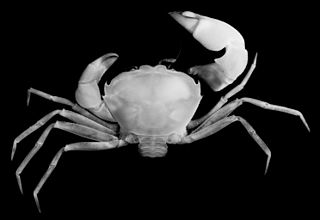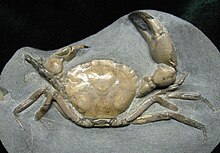
Plotopteridae is the name of an extinct family of flightless seabirds from the order Suliformes. Related to the gannets and boobies, they exhibited remarkable convergent evolution with the penguins, particularly with the now extinct giant penguins. That they lived in the North Pacific, the other side of the world from the penguins, has led to them being described at times as the Northern Hemisphere's penguins, though they were not closely related. More recent studies have shown, however, that the shoulder-girdle, forelimb and sternum of plotopterids differ significantly from those of penguins, so comparisons in terms of function may not be entirely accurate.

Nautilus is a genus of cephalopods in the family Nautilidae. Species in this genus differ significantly in terms of morphology from those placed in the sister taxon Allonautilus. The oldest fossils of the genus are known from the Late Eocene Hoko River Formation, in Washington State and from Late-Eocene to Early Oligocene sediments in Kazakhstan. The oldest fossils of the modern species Nautilus pompilius are from Early Pleistocene sediments off the coast of Luzon in the Philippines.

Nautilus cookanum is an extinct species of nautilus. It lived during the Eocene epoch. N. cookanum placed within the genus Nautilus, together with extant species based on their shared shell characters. Fossils of the species from the Late Eocene Hoko River Formation are noted as one of the two oldest occurrences for the genus.
Nautilus praepompilius is an extinct species of nautilus. It lived during the Late Eocene through Oligocene epochs. Fossil specimens have been uncovered from the Chegan Formation of Kazakhstan. N. praepompilius has been grouped into a single taxon together with extant species based on their shared shell characters. It is morphologically closest to N. pompilius, hence the name. The nepionic constriction shows that the hatching size was approximately 23 mm, close to that for N. pompilius. N. praepompilius, along with aff. N. cookanum fossils from the late Eocene Hoko River Formation in Washington state are the oldest occurrences of the genus.

Cancroidea is a superfamily of crabs, comprising the families Atelecyclidae and Cancridae Four other families have been separated into new superfamilies: Cheiragonidae into Cheiragonoidea, Corystidae into Corystoidea, and both Pirimelidae and Thiidae into Portunoidea.
Metacarcinus starri is an extinct species of crab in the family Cancridae, subfamily Cancrinae. The species is known solely from the early Miocene, Clallam Formation and the underlying Pysht Formation deposits on the Olympic Peninsula of Washington state, United States.
Homolodromiidae is a family of crabs, the only family in the superfamily Homolodromioidea. In contrast to other crabs, including the closely related Homolidae, there is no strong linea homolica along which the exoskeleton breaks open during ecdysis. The family comprises two genera, Dicranodromia, which has 18 species, and Homolodromia, with five species.
The Hoko River is a river in the U.S. state of Washington. It originates in the foothills of the Olympic Mountains, and runs about 25 miles (40 km) to the Pacific Ocean through a rugged landscape that has been heavily logged. Its largest tributary is the Little Hoko River, which joins at river mile 3.5-mile (5.6 km). The lower 1 mile (1.6 km) of the Hoko River is estuarine. The Hoko watershed supports chinook, chum, coho, and winter steelhead, with over 48 miles (77 km) of stream miles that provide suitable spawning habitat.

Carpilioidea is a superfamily of crabs containing a single extant family, Carpiliidae and three extinct families. The modern range of the family includes the Indo-Pacific, Western Atlantic and Caribbean Sea. The fossil record of the group extends back at least as far as the Paleocene.
Hexapodidae is a family of crabs, the only family in the superfamily Hexapodoidea. It has traditionally been treated as a subfamily of the family Goneplacidae, and was originally described as a subfamily of Pinnotheridae. Its members can be distinguished from all other true crabs by the reduction of the thorax, such that only seven sternites are exposed, and only four pairs of pereiopods are present. Not counting the enlarged pair of claws, this leaves only six walking legs, from which the type genus Hexapus, and therefore the whole family, takes its name. Some anomuran "crabs", such as porcelain crabs and king crabs also have only four visible pairs of legs. With the exception of Stevea williamsi, from Mexico, all the extant members are found either in the Indo-Pacific oceans, or around the coast of Africa.

Cheiragonidae is a small family of crabs, sometimes called helmet crabs, placed in its own superfamily, Cheriagonoidea. It comprises three extant species, Erimacrus isenbeckii, Telmessus acutidens and Telmessus cheiragonus, there are no yet evidences of Cheiragonidae in the fossil record. Many of these crabs were formerly treated as members of the Atelecyclidae.

Branchioplax is an extinct genus of crab which existed in Alaska and Washington during the Eocene period. It was first named by Mary Rathbun in 1916, and contains ten species , including Branchioplax washingtoniana from the Hoko River Formation, Branchioplax carmanahensis, and Branchioplax ballingi.

Pseudozioidea is a superfamily of crabs, formerly treated in the Eriphioidea, Carpilioidea, Xanthoidea, Pilumnoidea and Goneplacoidea. A number of fossils from the Eocene onwards are known from the family Pseudoziidae. Eleven genera are recognised in three families:

Azolla primaeva is an extinct species of "water fern" in the family Salviniaceae known from Eocene fossils from the Ypresian stage, found in southern British Columbia.

Oregonia is a genus of crabs, comprising two extant species and one fossil species: It is classified in the family Oregoniidae under the spider crab superfamily Majoidea.

Blepharipodidae is a family of sand crabs (Hippoidea), comprising the two genera Blepharipoda and Lophomastix. They are distinguished from the other families in the superfamily Hippoidea by the form of the gills, which are trichobranchiate (filamentous) in Blepharipodidae, but phyllobranchiate (lamellar) in Albuneidae and Hippidae. Fossils belonging to the genus Lophomastix have been found in rocks dating back to the Eocene.
This list of fossil arthropods described in 2012 is a list of new taxa of trilobites, fossil insects, crustaceans, arachnids and other fossil arthropods of every kind that have been described during the year 2012. The list only includes taxa at the level of genus or species.
This list of fossil arthropods described in 2017 is a list of new taxa of trilobites, fossil insects, crustaceans, arachnids and other fossil arthropods of every kind that are scheduled to be described during the year 2017, as well as other significant discoveries and events related to arthropod paleontology that are scheduled to occur in the year 2017.
This list of fossil arthropods described in 2018 is a list of new taxa of trilobites, fossil insects, crustaceans, arachnids and other fossil arthropods of every kind that were described during the year 2018, as well as other significant discoveries and events related to arthropod paleontology that are scheduled to occur in the year 2018.
This list of fossil arthropods described in 2019 is a list of new taxa of trilobites, fossil insects, crustaceans, arachnids and other fossil arthropods of every kind that are scheduled to be described during the year 2019, as well as other significant discoveries and events related to arthropod paleontology that are scheduled to occur in the year 2019.











